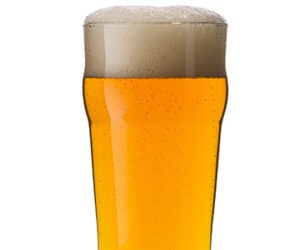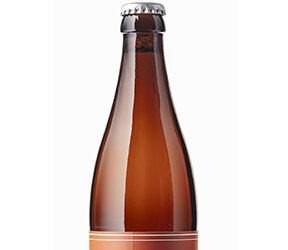Groom Lake IPA
—
Groom Lake IPA
(5 gallons/19 L, extract with grains)
OG = 1.056 FG = 1.014
IBU = 51 SRM = 9 ABV = 5.4%
Ingredients
1.5 lbs. (0.68 kg) US 2-row pale malt
0.5 lb. (0.23 kg) crystal malt (40 °L)
2 lb. 2 oz. (0.96 kg) light dried malt extract
4 lb. 2 oz. (1.9 kg) light liquid malt extract (late addition)
6 AAU Magnum hops (60 min.) (0.43 oz./12 g of 14% alpha acids)
3.5 AAU Simcoe hops (60 min.) (0.27 oz./7.6 g of 13% alpha acids)
7.5 AAU Centennial hops (15 min.) (0.75 oz./14 g of 10% alpha acids)
0.75 oz. (21 g) Cascade hops (5 min.)
1.5 oz. (43 g) Cascade hops (dry hop)
1 tsp. Irish moss (15 min.)
Wyeast 1056 (American Ale), White Labs WLP001 (California Ale) or Safale US-05 yeast (1.5 qt./~1.5 L yeast starter)
1.0 cup corn sugar (for priming)
Step by Step
Place crushed grains in a steeping bag. In a large kitchen pot, heat 3.0 qts. (2.8 L) of water to 163 °F (73 °C). Submerge grain bag in this water and let steep at 152 °F (67 °C) for 45 minutes. (If the temperature drops below 148 °F (64 °C), heat to 152 °F (67 °C) again.)
While grains are steeping, heat 1.5 qts. (~1.5 L) of water to 170 °F (77 °C) in a soup pan. Also, begin heating 2 gallons (7.6 L) of water to a boil in your brewpot. When steeping is done, place a colander over your brewpot and lift the grain bag into it. Pour the “grain tea” through the bag (which will strain out most of the grain bits), then rinse the bag with the 1.5 qts. (~1.5 L) of 170 °F (77 °C) water.
Heat the (roughly) 3 gallons (11 L) of wort in your brewpot to a boil, then stir in dried malt extract. (It will foam a bit, so don’t pour all the extract in at once.) Bring the wort back to a boil, add the 60-minute hops and boil for 60 minutes, adding late hops at times indicated. Stir in liquid malt extract and add Irish moss with 15 minutes left in boil.
During the boil, scrape any hops clinging to the side of the brewpot back into the wort. Also, do not let the wort volume drop below 2.5 gallons (9.5 L). Keep a small pot of boiling water handy to top up boil, if needed.
After the boil, put a lid on your brewpot and cool the wort (either in a cold-water bath in your sink or with a wort chiller). Cool until the side of the brewpot no longer feels warm, then let it sit for about an hour (with the lid on) to let the hop debris settle. With a racking cane, transfer the wort above the hop “sludge” to your fermenter. Pour the remaining wort/sludge slowly through a sanitized strainer.
Top wort up to 5 gallons (19 L) with cool water, aerate wort and pitch the yeast from your starter. Ferment at 70 °F (21 °F). When fermentation slows to a halt, rack to secondary. Add the dry hops a few days later, then bottle or keg after beer has been in contact with dry hops for 3–4 days.
—
Groom Lake IPA
(5 gallons/19 L, partial mash)
OG = 1.056 FG = 1.012
IBU = 51 SRM = 9 ABV = 5.7%
This version of Groom Lake IPA is more highly-attenuated than the extract with grains version and shows a little more malt aroma. Follow the instructions closely and the light color, high attenuation, alluring aroma and firm bitterness of this beer will render it unidentifiable as a stovetop beer.
Ingredients
3.5 lbs. (1.6 kg) US 2-row pale malt
0.5 lbs. (0.23 kg) crystal malt (40 °L)
1 lb. 12 oz. (0.79 kg) light dried malt extract
3 lb. 4 oz. (1.5 kg) light liquid malt extract (late addition)
6 AAU Magnum hops (60 min.) (0.43 oz./12 g of 14% alpha acids)
3.5 AAU Simcoe hops (60 min.) (0.27 oz./7.6 g of 13% alpha acids)
7.5 AAU Centennial hops (15 min.) (0.75 oz./14 g of 10% alpha acids)
0.75 oz. (21 g) Cascade hops (5 min.)
1.5 oz. (43 g) Cascade hops (dry hop)
1 tsp. Irish moss (15 min.)
Wyeast 1056 (American Ale), White Labs WLP001 (California Ale) or Safale US-05 yeast (1.5 qt./~1.5 L yeast starter)
1.0 cup corn sugar (for priming)
Step by Step
Put crushed grains in a large nylon steeping bag. Heat 5.5 qts. (5.2 L) of water to 163 °F (73 °C) and pour into your 2-gallon (7.6-L) cooler. Slowly submerge grain bag, then open the bag and use a large brewing spoon to ensure that grain mixes completely with the water. Let mash rest, starting at 152 °F (67 °C) for 45 minutes. While mash is resting, heat 0.75 gallons (2.8 L) of water to 152 °F (67 °C) in your brewpot and stir in dried malt extract. Hold the dissolved malt extract at 152 °F (67 °C). Also heat 5.5 qts. (5.2 L) of water to 180 °F (82 °C) in a large kitchen pot.
Recirculate your partial mash wort by drawing off a pint or two of wort from the cooler and returning it to the top of the mash. Repeat until wort is clear or 3 quarts (~3 L) have been recirculated. Next, run off entire first wort and add to the hot wort in your kettle. Continue holding wort in brewpot around 152 °F (67 °C) while you prepare to draw off the second wort.
Add 180 °F (82 °C) water to cooler until liquid level is the same as during the first mash. Let rest for 5 minutes, then recirculate and run off wort as before. Bring wort to a boil, add bittering hops and boil for 60 minutes. Add other hops at times indicated in ingredient list. Stir in liquid malt extract and add Irish moss with 15 minutes left in boil.
During the boil, scrape any hops clinging to the side of the brewpot back into the wort. Also, do not let wort volume drop below 3.0 gallons (11 L). Keep a small pot of boiling water handy to top up boil.
After the boil, put a lid on your brewpot and cool the wort (either in a cold-water bath in your sink or with a wort chiller). Cool until the side of the brewpot no longer feels warm, then let it sit for about an hour (with the lid on) to let the hop debris settle. With a racking cane, transfer the wort above the hop “sludge” to your fermenter. Pour the remaining wort/sludge slowly through a sanitized strainer.
Top wort up to 5 gallons (19 L) with cool water, aerate wort and pitch the yeast from your starter. Ferment at 70 °F (21 °F). When fermentation slows to a halt, rack to secondary. Add the dry hops a few days later, then bottle or keg after beer has been in contact with dry hops for 3–4 days.
Written by BYO Staff

Here’s an American IPA especially formulated by top BYO scientists for
stovetop extract brewers, not reverse engineered from an all-grain
recipe. Follow the instructions as closely as possible — especially with
regards to boil volume — for the best results.



